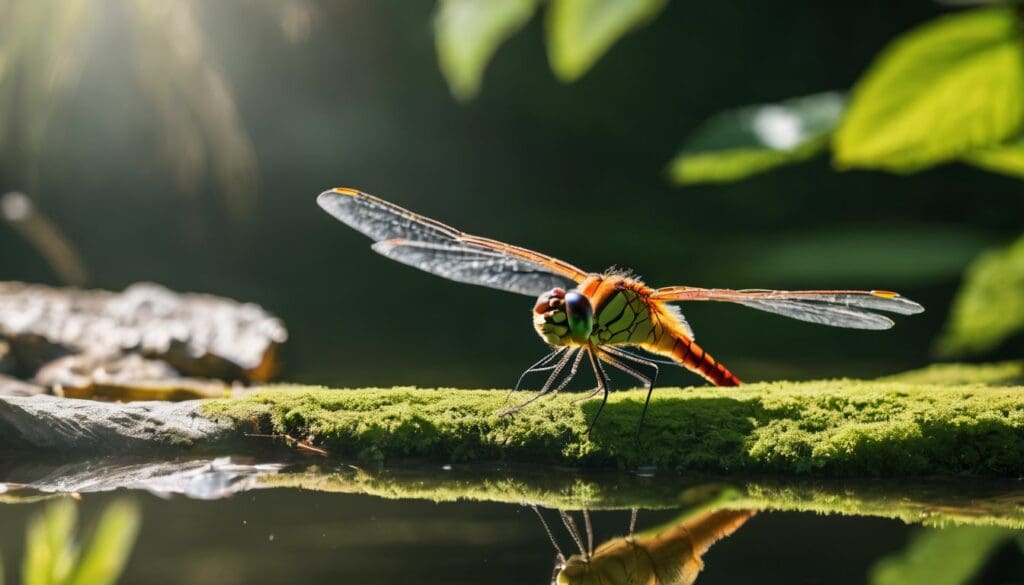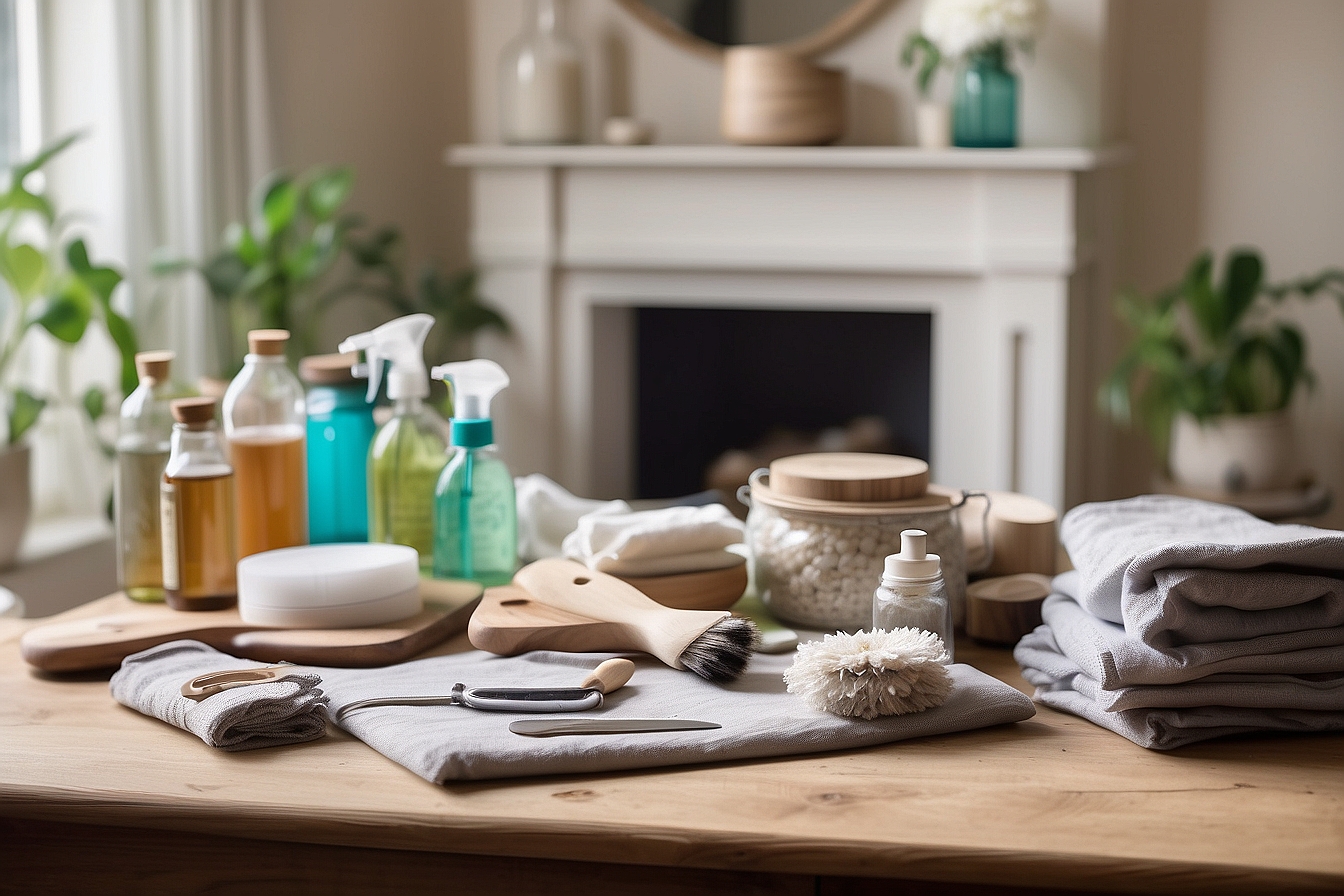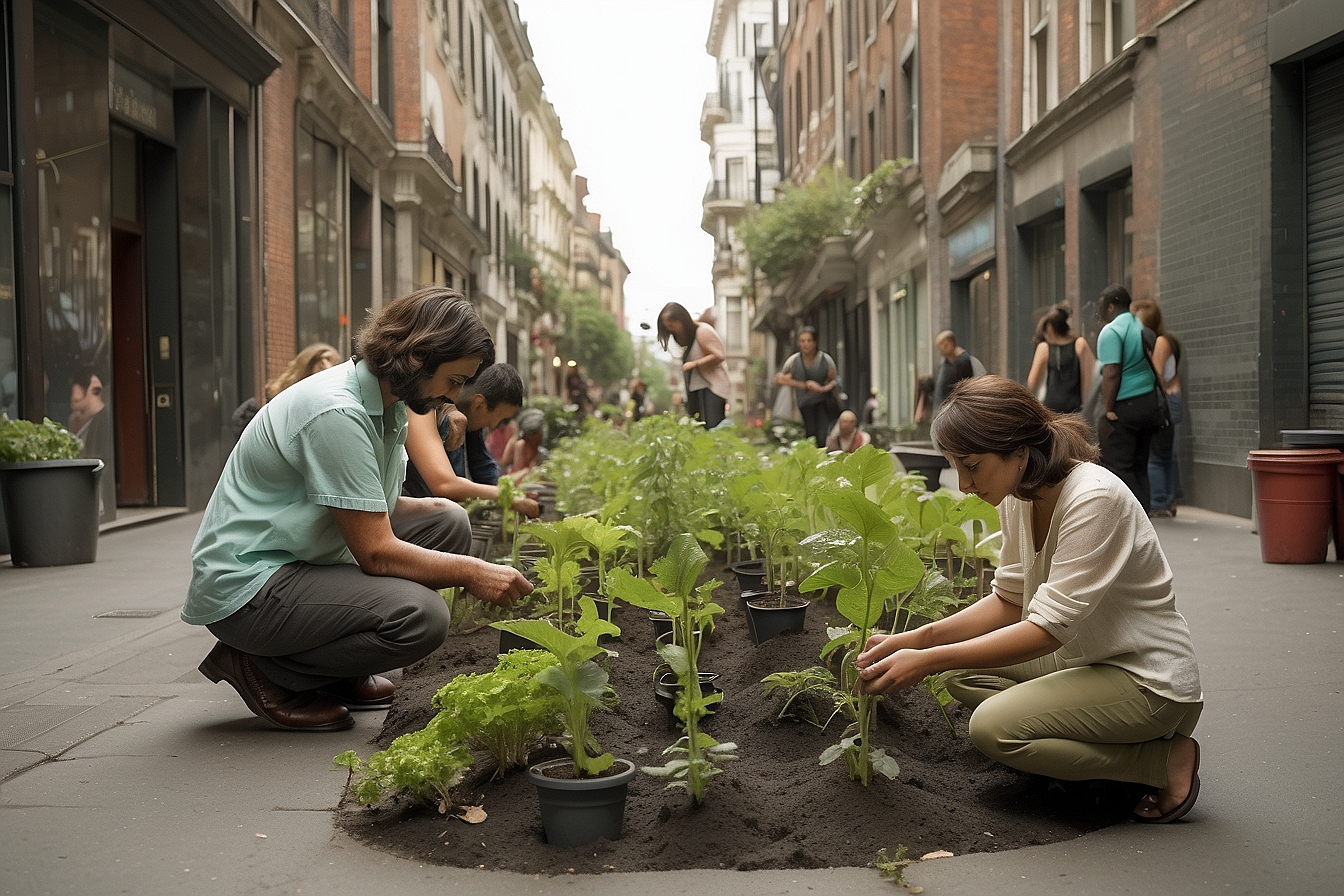Nurturing a flourishing garden is so much more than tending to your plants; it’s about embracing the entire ecosystem. We understand the longing to infuse your outdoor space with an abundance of life – we share that passion.
Our guide will kindly offer you step-by-step advice on how to craft a wildlife-friendly pond, one that will effortlessly weave itself into the fabric of your cherished garden sanctuary.
Let’s embark on this journey together – shall we take the plunge?.
Key Takeaways
- Choose a spot for your pond that gets balanced sunlight and shade, and make sure it has a minimum depth of 20 inches to support various wildlife.
- Incorporate shelves at different depths in your pond’s design, using native plants to provide natural habitats and food sources for creatures.
- Use a flexible liner when constructing the pond, add features like rocks or logs for shelter, and create ledges or beaches for easy access by wildlife.
- Maintain the health of your pond by regularly cleaning debris, monitoring water levels, and managing plant growth throughout the year.
- Enhance biodiversity by attracting species with nectar-rich flowers and providing shelters like bee hotels; engage in pond dipping to discover aquatic life.
Choosing the Right Location for Your Pond
Choosing the right location for your pond is crucial for the success of your wildlife habitat. Consider factors like light, shade, and depth to provide a suitable environment for aquatic plants and animals.
Consider light and shade
In our quest to create a biodiverse garden pond, let’s not overlook the importance of balancing light and shade. The right amount of sunshine encourages aquatic plants to thrive, essential for a healthy pond ecosystem.
Yet too much can lead to excess algae, turning our wildlife haven into murky waters. We’ll place our water feature where it receives some dappled sunlight but is also graced by refreshing shadows from nearby trees or structures.
By thoughtfully positioning rocks and planting at varying heights around the edges, we craft natural sun hats and umbrellas for creatures seeking respite or concealment within the habitat we’ve provided.
It’s all about creating microclimates that cater to different species’ preferences—shimmering spots for dragonflies alongside cool retreats for frogs and newts under leafy canopies.
Together we’re building sustainable homes that celebrate life in all its forms, right there in our gardens.
Ensure a minimum of 20 inches depth
After considering light and shade, ensure a minimum of 20 inches depth to provide a suitable habitat for wildlife. The depth will help maintain stable water conditions and support diverse aquatic life, attracting frogs, newts, birds, and insects.
This depth also offers refuge during extreme weather conditions.
Include shelves for plant habitat. Use native plants to promote biodiversity in the area surrounding your pond without impacting the ecosystem significantly.
Include shelves for plant habitat
When designing your wildlife pond, ensure to include shelves for plant habitat. These shelves should be strategically placed at different depths within the pond to accommodate a variety of aquatic plants.
This not only provides shelter and food for different species but also creates a more natural and biodiverse ecosystem within your pond. By including these shelves, you’ll be able to support a wide range of flora and fauna, helping to maintain the balance and health of your garden wildlife pond while attracting an array of wildlife throughout the year.
To optimise the effectiveness of these shelves in providing habitat for plants, consider using native species that are well adapted to your local environment. Additionally, utilising rocks or logs on these shelves can provide hiding spots for smaller creatures and contribute to creating a naturalistic underwater landscape in your pond.
Best Practices for Building Your Pond
– When building your wildlife pond, it’s important to use a flexible liner to allow for natural movement and avoid cracks. Creating a beach or ledge will provide easy access for wildlife, while adding rocks and logs will offer shelter and nesting areas.
Using native plants in your pond will also help maintain a balanced ecosystem.
Use a flexible liner
When building a wildlife pond, we recommend using a flexible liner to create the base. Ensure that the liner is thick and durable to withstand outdoor elements and provide the necessary flexibility for shaping your pond.
Using a flexible liner allows you to customise the shape of your pond, ensuring stability along the bank while providing support for plant habitats and sheltered areas for wildlife.
Additionally, this type of liner provides an effective barrier against water leakage, helping to maintain consistent water levels throughout all seasons. Selecting a high-quality flexible liner will contribute to the sustainability and longevity of your wildlife pond ecosystem.
Create a beach or ledge
To provide a comfortable habitat for wildlife in the pond, we can create a beach or ledge within the design. This feature serves as an ideal spot for amphibians, birds, and other creatures to access the water easily.
By carefully creating this gentle slope around the edge of the pond, it offers a safe entry and exit point for animals while also providing a crucial area for basking in the sun or resting near shallow water.
Adding a beach or ledge to your wildlife pond not only enhances its natural appearance but also contributes to supporting various species by offering an accessible and inviting environment.
Add rocks or logs for shelter
Position rocks or logs along the edges of your pond to provide shelter for wildlife. This will create hiding places and resting spots for frogs, newts, and small mammals. These features also attract insects which are a food source for various pond dwellers.
Arrange the rocks or logs in a way that allows easy access to the water while providing cover from predators. Be mindful of keeping them stable to prevent any accidental collapse into the pond, ensuring safety for all creatures seeking refuge there.
Use native plants
Native plants are crucial for creating a thriving ecosystem in your wildlife pond. They provide food and shelter for local wildlife, attract beneficial insects such as bees and butterflies, and help maintain the balance of the pond’s ecosystem.
Planting native species also contributes to environmental conservation efforts by preserving the natural biodiversity of the area.
Introducing native plants to your garden wildlife pond not only enhances its aesthetic appeal but also ensures a sustainable habitat for local wildlife. When selecting native plants, consider those that will thrive in your specific climate and soil conditions to support a diverse range of species.
By incorporating these indigenous plants into your pond environment, you can establish a biodiverse ecosystem that benefits both the local wildlife and the surrounding environment.
Caring for Your Pond Throughout the Year
Regular maintenance is key to keeping your pond healthy and thriving. Keep an eye on water levels, clean and remove debris as needed to keep the ecosystem balanced.
Regular maintenance
To maintain our wildlife pond, we regularly check the water levels and clean out any debris. We also trim plants as needed to ensure a healthy ecosystem for wildlife. Furthermore, we inspect the pond infrastructure for any signs of wear and tear, like liner damage or bank erosion.
We strive to keep our wildlife pond in top condition by following these regular maintenance practices. Next, let’s delve into monitoring water levels to maintain an optimal habitat for local wildlife.
Monitoring water levels
Throughout the year, we regularly check and adjust the water levels in our pond. We keep an eye on the depth to ensure that it remains stable and provides a suitable environment for wildlife.
By monitoring water levels, we can also prevent issues such as low oxygen levels or stagnant water.
We use a simple gauge or marker near the pond’s edge to track any changes in water level. If needed, we top up the pond with rainwater to maintain its balance. Checking and adjusting water levels is crucial for maintaining a healthy ecosystem within our garden pond—ensuring it continues to attract various wildlife species throughout the seasons.
Cleaning and removing debris
Regularly clearing out leaves, twigs, and other debris from the pond helps maintain water clarity and prevents nutrient build-up. Using a skimmer net or pond vacuum can make this task easier, especially during autumn when falling leaves can quickly accumulate.
Removing excess organic matter reduces the risk of algae overgrowth, keeping the ecosystem balanced and healthy for wildlife to thrive.
Taking time to clean the filters in your pond pump helps prevent clogging and ensures efficient water circulation. Additionally, trimming back any overhanging branches or plants near the pond can minimise debris entering the water, reducing maintenance needs while preserving a natural look for your wildlife habitat.
Attracting Wildlife to Your Pond
Spotting different species each season and attracting wildlife in summer, winter, and through pond dipping. Additionally, learn how to attract specific species like bees and butterflies to your garden wildlife pond.
Different species to spot each season
- Spring:
- Frogs and toads begin their mating rituals.
- Pond skaters and water boatmen start to appear on the water’s surface.
- Summer:
- Dragonflies and damselflies can be seen darting around the pond.
- Butterflies are attracted to nectar – rich plants near the water’s edge.
- Autumn:
- Birds stop by for a drink or bathe in the shallow edges before migrating south.
- Newts emerge from hibernation to feed and mate.
- Winter:
- Waterfowl such as ducks and geese may visit your pond when other sources freeze over.
- Amphibians, like frogs, hibernate at the bottom of the pond.
Attracting wildlife in summer
During the summer, we can attract a variety of wildlife to our ponds by incorporating floating plants like water lilies and water hyacinths. These provide shade for fish and attract insects that birds feed on.
Planting native vegetation around the pond such as ferns, wildflowers, and grasses will create a diverse habitat for amphibians, reptiles, and small mammals. Setting up shallow areas in the pond with rocks or logs allows animals like frogs and turtles to bask in the sun, while also providing a safe spot for them to lay their eggs.
Additionally, installing a bird bath near the pond provides an additional water source during hot weather. Bees and butterflies can be attracted by planting nectar-rich flowers nearby – they are essential pollinators contributing to biodiversity.
Winter pond wildlife
As the temperatures drop, our wildlife pond transforms into a haven for winter visitors. Migratory birds such as ducks and geese are known to seek out water sources during this time, making your pond an ideal spot for observation.
The colder months also bring different amphibians seeking refuge in the water, and if you’re lucky, you might even catch a glimpse of otters or mink venturing near the frozen edges in search of food.
As nature slows down around us, observing these winter residents offers a unique perspective on the ecosystem we’ve created.
Creating a space that remains hospitable to wildlife during the winter is essential. Ensure there’s no ice cover completely sealing off access to unfrozen water by using a pond heater or agitator to maintain an opening.
Pond dipping for discovery
Grab your nets and buckets! Pond dipping is an exciting way to observe the fascinating creatures inhabiting your wildlife pond. Carefully skimming the water’s surface with a net, you might uncover a whole world of tiny organisms – from wiggling insects to darting tadpoles.
Care for safe exploration guidelines, and make sure any captured wildlife is gently released back into their watery home after observation.
Inspecting your finds under a magnifying glass can reveal intricate details that are otherwise missed. However, always prioritise respect for these creatures’ habitats and well-being by handling them carefully.
Attracting specific species like bees and butterflies
After enjoying the excitement of pond dipping for discovery, we can further enhance the biodiversity of our garden wildlife pond by attracting specific species like bees and butterflies.
Planting a variety of nectar-rich flowers such as lavender, heather, and buddleia will entice these essential pollinators. Creating habitats that provide sheltered spots for solitary bees to nest in is also key.
Consider providing special bee hotels or areas with undisturbed soil for them to build their nests.
Butterflies are attracted to sunny areas with windbreaks such as hedgerows. By offering an array of nectar-producing plants that bloom at different times throughout the year, we can help sustain butterflies from spring through autumn.
Providing moisture sources like damp sand or mud patches will support butterflies in need of hydration and minerals crucial for reproduction.
Conclusion
Design a diverse garden pond to attract local wildlife. Choose an ideal spot, ensuring the right depth and plant shelves. Use native plants for a thriving ecosystem. Regularly maintain the pond to ensure its health throughout the year.
Discover seasonal wildlife changes through careful observation and interactions with them.
FAQs
1. How do I start building a garden wildlife pond?
To begin creating a backyard wildlife pond, design a natural layout and choose where to dig. Use flexible pond liner or go for a natural look without one.
2. What features should I add to make my garden pond wildlife-friendly?
For constructing a small wildlife pond, adding plants and rocks helps create habitats and provides shelter for different creatures.
3. Can I make a stable bank for my wildlife pond?
Yes, ensuring the stability of the bank is crucial when building your wildlifefriendly water feature; it offers nesting areas and protection for wildlife visitors.
4. Is it difficult to maintain a garden wildlife pond?
Pond maintenance can be easy if you set up your habitat correctly from the start by designing your naturalistic pond with biodiversity in mind.
5. Why should I consider adding a wildlife conservation water feature in my yard?
Building a sustainable wildlife conservation pool supports local ecosystems, attracting various species while offering an engaging area for observation and enjoyment.





